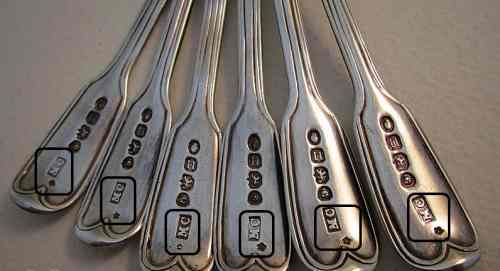|
|
JOURNEYMAN MARK
WORKMAN MARK
The word journeyman comes from the French word journée, which means a period of one day.
It refers to the right the jouneyman had to obtain a reward for each day's work.
In origin he was "a man who did not gain the freedom of the City and was therefore a 'non Freeman' but was free of a livery company and thus qualified to ply his trade could do so as a 'journeyman' provided he was licensed by the corporation. Often he would continue to work for his old master in the capacity of journeyman but he could, if he wished, go to another workshop and sometimes a silversmith would remain a journeyman for all of his working life" (courtesy David Mckinley/ASCAS).
The majority of silversmiths never actually registered their own mark. They were employed by large workshops of companies or were used as out-workers. The work they part or wholly produced was marked under somebody else's name.
These workers on plate were often paid on a pro rata basis, the foreman counting up their output each day so that they could be rewarded at the end of the week. The foreman also could distinguish between each of his workers' wares so that poor workmanship could be traced to the source. Thus a system was devised where each member of staff had his own punch, sometimes cut with the initials, but more often cut with a small symbol (a star, a leaf, a triangle, etc.)
|

After the middle of the 19th century hand-forged flatware met with a serious rival, machine-made pieces.
The machine-made flatware, although of inferior quality, was largely cheaper and after 1850 the workman marks became no longer necessary and their use ceased in the 1870s.
This page presents a selection of journeyman/workman symbols found on flatware marked by Chawner family.
Under various styles (William Chawner II, Mary Chawner, Mary Chawner & Co, Chawner & Co/George William Adams) Chawner workshop was, possibly, the most prolific manufacturer of spoons and forks of London in the 19th century.
|

www.silvercollection.it |
This is a page of 'The What is? Silver Dictionary' of A Small Collection of
Antique Silver and Objects of vertu, a 1500 pages richly illustrated website offering all you need to know about
antique silver, sterling silver, silverplate, Sheffield plate, electroplate silver,
silverware, flatware, tea services and tea complements, marks and hallmarks, articles,
books, auction catalogs, famous silversmiths (Tiffany, Gorham, Jensen, Elkington),
history, oddities ...
HOME - SITE MAP - SILVER DICTIONARY - COOKIES CONSENT AND PRIVACY |
| |